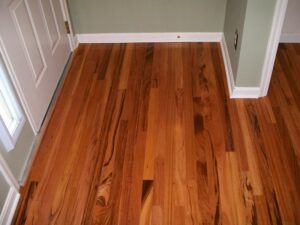Ever walked into a tile showroom and thought, “Wait, aren’t ceramic and porcelain tiles basically the same?” You’re not alone.
At first glance, they can look nearly identical, but beneath the surface, there are key differences that can make or break your flooring project.
Choosing the right tile can transform your home, but many don’t know the difference between ceramic and porcelain tiles. This blog explains how these tiles differ and helps you decide which one is best for each room in your home.
Understanding the Basics
Ceramic and porcelain tiles are both made from clay and baked in ovens, but porcelain tiles are fired at higher temperatures. This makes porcelain denser, more water-resistant, and ideal for wet, high-traffic areas.
Ceramic tiles are more porous, better for low-traffic spaces, easier to install, and usually more budget-friendly. Both are durable and long-lasting options. So when people ask about porcelain tiles vs ceramic tiles, the answer is all about how and where you plan to use them.
Which Tile is Better for Each Room?
Every room in your home has different needs, making the choice between ceramic vs, porcelain tiles important. Bathrooms and outdoor spaces benefit from porcelain tiles because they resist water, cracks, and weather damage.
For kitchen floors, porcelain tiles vs ceramic tiles usually favors porcelain for its durability and low water absorption. Ceramic tiles work well on kitchen walls and backsplashes due to their variety and affordability.
In living rooms and bedrooms, ceramic offers warmth and style, while porcelain is best for high-traffic or wet areas. Understanding porcelain vs ceramic tiles helps you pick the right tile for each space.

What Makes Porcelain and Ceramic Tiles Different?
Porcelain tiles cost more because they last longer and need less maintenance, making them ideal for high-traffic or wet areas like kitchens. They offer durability with glaze finishes and low grout lines. Ceramic tiles are cheaper, easier to cut, and great for low-traffic areas or DIY projects.
Both types may need sealing in moist spots and come in many colors and styles to fit any home design. At Floor Guys, we also help you find flooring options that fit your budget and personal preference.
Still Can’t Decide? Here’s a Quick Tip
Think about how the room is used. If the room often gets wet or dirty, like your bathroom, kitchen, or laundry room, porcelain tiles are better. They’re more durable, highly resistant, and hold up in messy situations. So, choose porcelain for your bathroom tiles.
If the room is mostly dry and quiet, like a bedroom or guest room, ceramic tiles should be just fine. They’re stylish, easy to work with, and more budget-friendly per square foot.
Also, if you’re thinking about tiles that match with other upgrades, check out some carpet flooring options and kitchen wrap services for a full home makeover.
Maintenance Tips for Ceramic and Porcelain Tiles
Choosing the perfect tile is only half the story, maintaining it properly ensures your floors and walls stay beautiful, clean, and damage-free for years to come. Whether you are going for ceramic or porcelain tiles, both need regular care to preserve their appearance and performance.
1. Daily & Weekly Cleaning Routines
Dust, dirt, and grit can act like sandpaper on tile surfaces. Use a soft broom or vacuum with a hard floor setting to remove debris. Also, damp mop once or twice a week using warm water and a pH-neutral cleaner designed for tiles. Avoid harsh chemicals like bleach or ammonia, they can dull the glaze or cause discoloration over time.
Pro Tip: For a natural option, mix a few drops of dish soap in a bucket of warm water. Avoid oil-based cleaners, they can leave slippery residues.
2. Deep Cleaning Ceramic vs. Porcelain
Because ceramic is more porous, it can hold onto dirt in its tiny surface holes. Deep clean with a soft-bristle brush and baking soda paste or a gentle tile cleaner. Less porous and denser, porcelain resists deep stains better. A diluted vinegar solution can help remove soap scum and hard water stains from porcelain tiles in bathrooms.
Important: Always test a new cleaning solution on a small, hidden area before using it across the entire floor.
3. Grout Maintenance
Grout lines are the most vulnerable part of your tile setup, they absorb moisture and stains quickly. Use a toothbrush or small grout brush with a baking soda and vinegar solution. Rinse thoroughly. Every 6–12 months, apply a quality grout sealer to prevent staining and moisture buildup, especially in kitchens, bathrooms, and laundry rooms.
4. Protecting Tile from Damage
Even the strongest tiles can crack or chip under impact or heavy pressure. Add felt pads to the chair and furniture legs to prevent scratches. Also, in high-traffic zones like entryways or hallways, rugs reduce wear and tear. Lastly, always lift heavy furniture or appliances instead of sliding them across tile surfaces.
5. Water & Moisture Control
Porcelain is naturally more water-resistant than ceramic, but both types still need protection from standing water or excessive moisture. Wipe up spills quickly, especially in kitchens or bathrooms, where puddles can seep into grout. Also, use exhaust fans or open windows after showers to reduce moisture buildup on tile walls and floors.
Conclusion
Choosing between ceramic and porcelain tiles doesn’t have to be overwhelming, it’s all about matching the right material to the right space. Porcelain tiles shine in areas where moisture, heavy foot traffic, or durability are top concerns, while ceramic tiles offer flexibility, style, and affordability for low-traffic or decorative spaces. By understanding the core differences, such as water resistance, strength, cost, and ideal usage, you can make smart choices that enhance your home’s beauty and functionality. Still unsure which tile is best for your project? Let the experts at Floor Guys guide you through the process. Call us at +971 585498158 or email sale@floor-guys.com to get started today!
Frequently Asked Question
What is the main difference between porcelain and ceramic tiles?
Porcelain tiles are harder and absorb less water, while ceramic tiles are softer and more absorbent. This key difference affects their durability and best uses in various spaces.
Can I use ceramic tiles in my bathroom?
Yes, ceramic tiles work well for walls, but porcelain tiles are safer for floors since they resist water better, making them ideal for wet areas like bathrooms and kitchens.
Are porcelain tiles more expensive?
Yes, porcelain tiles typically cost more but last longer than ceramic tiles, especially in wet or high-traffic areas where durability and water resistance are essential.
Do ceramic tiles crack easily?
Ceramic tiles may crack in wet or high-pressure areas. For best results, use them in dry, low-traffic spaces where they won’t face heavy moisture or wear.
Which one should I use outside on my balcony?
Porcelain tiles are perfect for outdoor use because they resist water, weather, and temperature changes better than ceramic tiles, making them ideal for balconies, patios, and other exposed spaces.






